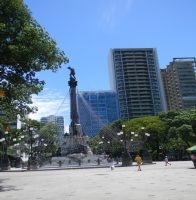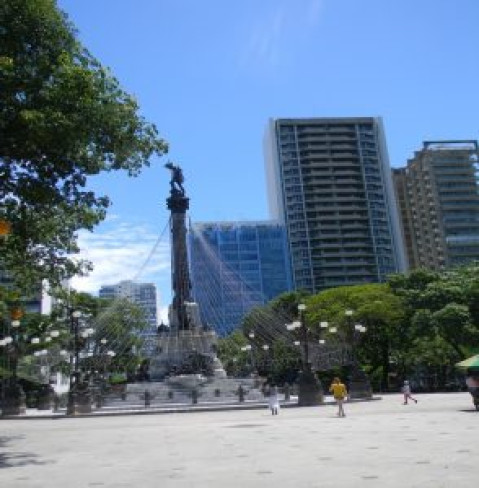Widgetized Section
Go to Admin » Appearance » Widgets » and move Gabfire Widget: Social into that MastheadOverlay zone
The Twilight of Old Government: Timeless Lessons in Public Service
The views expressed are those of the author and do not necessarily reflect the views of ASPA as an organization.
By Lisa Saye
December 18, 2018

São Salvador da Bahia de Todos os Santos, Brazil, City View and Coastline, Photo by Lisa Saye
More than Perfect
The end of a year always forces one to conjure up all of the sentimentality they can imagine. Some of that sentimentality is tinged with negative thoughts, while other thoughts seamlessly attach themselves to what is hoped for or wished for in the next year. While I cannot speak for every public servant around the world, my hopes and wishes for next year and years to come can be summed up as Pax Governo, or a more peaceful government. Forgive my rough Italian translation, but for me, the notion of being governed in less chaos is more than a holiday wish. And, I am not alone in wanting government stability over government instability. Take for example, the narrative in the Preamble to the U.S. Constitution that states, “in order to form a more perfect union,” a document outlining justice, domestic tranquility, defense, general welfare and liberty as its core features is what We, the people, require.
You probably think I am waxing on in sentimentality regarding the U.S. Constitution. I would say you are partially correct. The sentiment I most admire in the U.S. Constitution is the one that is implied and explicit in its self-correcting role. The Constitution’s amending power and authority provides a future of debate and change as needed. Since I, nor anyone else, is never truly clairvoyant on all things government, an amendment serves as a mechanism of context. In this way, amendments help to make the Constitution or any founding document more than perfect. In fact, amendments make a governments’ constitution timeless.

São Salvador da Bahia de Todos os Santos, Brazil, City Center, Photo by Lisa Saye
Public Service and Patterns of Efficiency
For the past few months, I have quietly observed public servants at work. Whether noticing them as I renewed my Driver’s License, registered my car, mailed postcards or attended a mayoral event, I have come to admire their unwavering commitment to serve us — their public. What stands out is that within most encounters with public servants one comes away feeling like they had an encounter with someone they know and more importantly with someone who seems to care.
I have lived in small cities, medium-sized cities and large cities. I have watched my fellow public servants hard at work, problem-solving and many times exhibiting noted patterns of efficiency. There seems to be no issue that they are not prepared to correct, discuss or learn from.
So, what’s new about my observations? Not much, if you consider the ancient writings scribbled on cave walls or notes about the work of public servants that every civilization has recorded since the formation of government. My eyes may observe the burgeoning technology ancient civilizations could have or could have never imagined, but the questions then and now are generally the same. What we all want is a government that serves everyone and one where we can count on patterns of efficiency that help us to go about our day.
In a previous column entitled, “Public Service in A Place of Meaning: What We Can Learn From 13 Truckers,” I talked about twilight and blue moments when referencing the instances when public servants are at their best. In his 1969 book, The Rise of Modern Europe: Political and Social Upheaval (1832 -1852), William Leonard Langer opened his text with observations regarding the twilight of the old society. His discussion highlighted the degree to which the monarchy and nobility, although intact at that time, were indeed in their twilight. During this time, recorded history is replete with stories of fundamental changes to the old rule and how new government structures were being formed. With the changes that the world has witnessed in the past few years, we may indeed be witnessing our own twilight of government and subsequently that of public service.
To be certain, government work is no day at the beach that can be summarized in a photo of a picturesque city by the sea. Government work should be structured in a way that helps explain and eliminate the existence of inequality among its citizens. In being less chaotic, government and its vast and diverse array of public servants can ensure that consistent daily operation is one of the elements within the pattern of efficiency. While amendments help to usher in the new normal in a changing society, public servants are part of the infrastructure that merges the new changes into the fabric of the old foundations. These servants know where the house settles, where the door or window used to be and how old the curtains are. They make the impossible quite possible and will wake up tomorrow and do it all again. Public servants are not perfect, but each day they demonstrate the patterns of efficiency that show that they know how to get there.
Images: All images were taken by Lisa Saye in São Salvador da Bahia de Todos os Santos, Brazil.
Author: Lisa Saye teaches Research Methods at The School of Public Service at DePaul University. She served as Fulbright Specialist in Phnom Penh, Cambodia and as International Consultant for the United Nations Development Program in The Maldives. In April, she attended the United Nations High-Level Meeting on Peace-Building and Sustaining Peace as an Observer. Saye earned her Master’s in Human Resource Management from Troy University and her Doctorate in Public Administration from The University of Alabama. She can be reached at [email protected].






Marquice Robinson
December 19, 2018 at 3:25 pm
Hello Dr. Saye,
Great job once again!
Marquice Robinson
December 18, 2018 at 5:25 pm
Hello Dr. Saye,
Your knowledge, and attention to detail in your work is superb. Governmental leaders need to read your work, and maybe the US government can function better. Job well done!
Hassan Elkatawneh
December 18, 2018 at 3:21 pm
first I would like to thank you for the great article
I would like to refer to a concept that has emerged in this article about the pattern of efficiency, which I think is a concept that we are exposed to in many aspects of our daily lives, but at the same time we do not know who is behind this pattern, which represents solutions to more general and abstract problems, For structuring things generally lead to faster programs, fewer problems, and higher abstraction. Therefore, I think it is the duty of researchers and governments to speed up the development and dissemination of efficiency patterns in a more effective way. Which I think is another constitution that deals with people’s affairs on a daily basis
Mike Nwosu
December 17, 2018 at 3:50 pm
Hi Prof,
Once more, you have displayed a Mastery of the subject matter. You’re indeed an Administrator par excellence. You not only have the answers but the solutions.